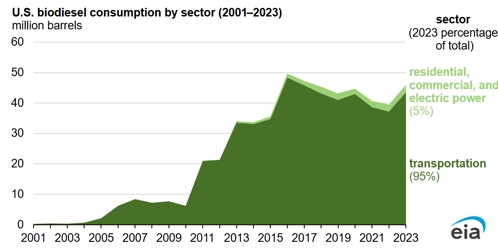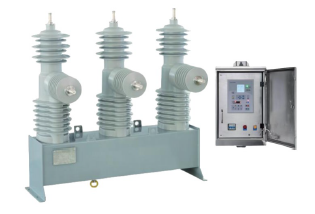Wedoany.com Report-Mar 27, A small but increasing amount of biodiesel in the United States is consumed in the residential, commercial, and electric power sectors, according to new estimates now published in the U.S. EIA's State Energy Data System. Previously, the association allocated all U.S. biodiesel consumption to the transportation sector, where the vast majority of biodiesel is consumed.
Biodiesel is a renewable fuel produced using fats, oils, or greases usually blended with petroleum diesel and consumed by trucks. In 2023, the most recent year for which we have estimates, the transportation sector accounted for about 95% of the nearly 46 MMbbls of biodiesel consumed in the U.S.
Biodiesel can also be blended with heating oil to heat homes and businesses. We estimate that the residential and commercial sectors combined accounted for nearly 5% of U.S. total biodiesel consumption in 2023, up from about 1% a decade earlier. The introduction of biofuel blending mandates for heating oil in some northeastern states is contributing to that growth. Although customers in other states likely blend biodiesel to heat homes and businesses, we only estimate consumption for New York, Connecticut, and Rhode Island.
Consumption of biodiesel in the residential and commercial sectors is higher in New York than in any other state, accounting for 57% of the U.S. total for those sectors in 2023. New York City passed the nation's first law requiring biodiesel blending with heating oil, mandating a minimum 2% biodiesel blended with heating oil beginning in 2012. Later, New York enacted a 5% minimum state-wide blend law beginning in 2022, which increases to 10% in 2025 and 20% in 2030. According to the U.S. Census Bureau’s American Community Survey, nearly 16% of homes in New York used heating oil as their primary heat source in 2023, about four times more than the U.S. average of about 4%.
Connecticut and Rhode Island also have similar state-wide minimum biofuel blend laws for heating oil. Connecticut’s 5% blend law began in 2022 and ramps up to 10% in 2025, 15% in 2030, 20% in 2034, and 50% in 2035. Rhode Island was the first state to enact a minimum biofuel heating oil blend law that began with a 5% blend in 2017 and increased to 10% in 2023. Rhode Island’s blend law increases more quickly than the other states—up to 20% in 2025 and 50% in 2030. More than 34% of homes in Connecticut and 26% of homes in Rhode Island reported heating oil as their primary heat source in 2023.
Biodiesel can also be burned to generate electricity, and the electric power sector accounted for less than 1% of U.S. biodiesel use in 2023. In 2006, a test plant in Tennessee reported the first biodiesel use for electric power in the U.S. Hawaii has accounted for nearly all U.S. biodiesel consumed for electric power since 2009. In 2023, petroleum fueled about 68% of Hawaii’s total electricity generation, the highest share of any state, and we estimate that biodiesel fueled about 1% of the state’s total generation.

















